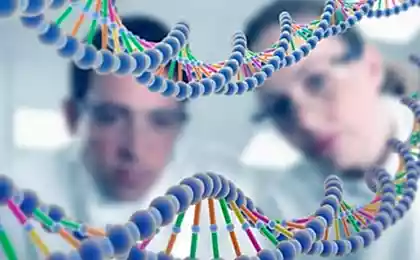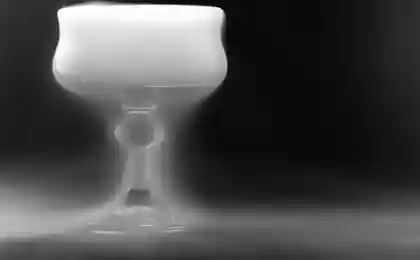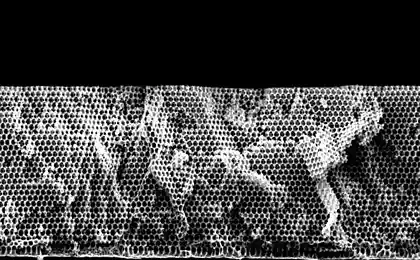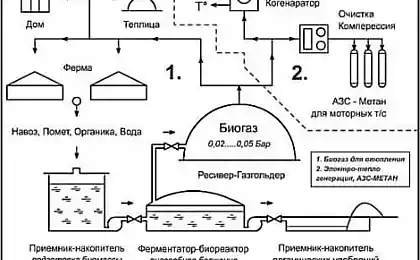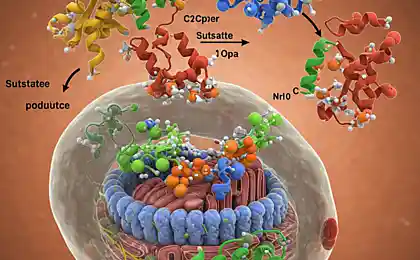495
Scientists have developed a new method to convert carbon dioxide into organic matter
Carbon dioxide (CO2) can become the most important raw material carbon future green economy. This requires the development of efficient technologies for its conversion into multicurrency compounds that will form the basis for many biotechnological products ranging from biofuels and ending with drugs.
Despite the tremendous diversity of organisms able to produce enzymes for the conversion of carbon dioxide into organic compounds, so far nobody has been able to use this opportunity to convert CO2 into biofuel or renewable sources for valuable chemicals. Too high a concentration of carbon dioxide in the atmosphere is a serious problem, but some scholars see it as an opportunity.

"Biological fixation of carbon requires several enzymes for the conversion of CO2 into biomass. Although this path has evolved in plants, algae and microorganisms for billions of years, many reactions and enzymes can help in the production of the necessary chemical products, not biomass", — reported in a scientific paper published in the journal Science.
A team of researchers from the Institute for terrestrial Microbiology max Planck Society in Marburg, Germany, has developed for plants with new highly efficient method of recycling CO2. It is based on a new enzyme for carbon sequestration, by which this process could hypothetically go 2-3 times faster.
Plants and algae quite well manage to reduce the amount of carbon dioxide in the atmosphere. Annually, they consume about 350 billion tons of CO2 worldwide. Almost all plants do this by using the same chemical process, several chemical reactions called the Calvin cycle.
The Calvin cycle is a set of molecular reactions, in which simple three atom molecule of CO2 is slowly converted into glucose, a complex sugar. This method is quite well-established by evolution, but scientists have found a way to improve it.
Successful completion of the Calvin cycle depends on the specific molecular tool – ribulosebisphosphate (RuBisCO) – enzyme that captures CO2 from the atmosphere and forms a large molecule, to begin the transformation. The problem is that RuBisCO makes it relatively slow. In addition, each fifth attempt RuBisCO to fix CO2 leads to loss of carbon from the Calvin cycle and reduces the efficiency of photosynthesis.

Biochemists led by Tobias Albom developed an in vitro cycle of carbon absorption, very similar to the Calvin cycle. The main difference of the new method is that it uses faster and more efficient molecular tool – ECR enzyme that performs the same work as RuBisCO, is only about 9 times faster. ERB called this process cycle CETCH. In addition to the enzyme ECR, scientists by sequencing and synthesis brought 16 more catalysts from 9 different organisms to CETCH cycle.
Cycle CETCH makes a portable air CO2 the glyoxylate 11 steps. At each step requires an enzyme that transforms molecules. Each of these enzymes were carefully selected from 40 thousand known catalysts. Some of them found in the human body and intestinal bacteria, others have taken of the plants and the microbes that live in the oceans.
ERB and his colleagues checked CETCH cycle in the laboratory. They put all the extracted catalysts with a certain amount of chemical fuel and calculated how much carbon dioxide was removed from air. They found that their cycle is 25% more efficient than the Calvin cycle in plants and algae. CETCH converts carbon dioxide into organic molecules with a speed of 5 nmol of CO2 per minute per milligram of protein.
Encouraged by the successful restoration of enzymatic synthetic networks in vitro, which, moreover, can compete with natural cycles, ERB opens several doors for the use of technology CETCH. If you enter synthetic enzymes in a living organism, the cycle CETCH will support the natural photosynthesis. In the end, he can serve as an impetus for the development of self-sufficient, fully-synthetic carbon metabolism in bacterial and algal systems.
ERB notes that at this stage it is very difficult to predict how fast will be synthesized CETCH compared to the Calvin cycle which works in living organisms. But since it is fewer steps and enzymes faster, scientists expect the acceleration in two or three times. In the end, it can be a bit slower than the Calvin cycle. Scientists simply don't know that yet.

Although glyoxylate, which is produced during the cycle CETCH largely useless by itself, it can be easily converted into another chemical, suitable for the production of biofuels or antibiotics.
Scientists hope that one day the cycle CETCH can be implemented in a living organism using genetic engineering techniques. However, this is a very difficult task for which you want to conduct a lot of research. Now the team Erba has not the slightest idea of what will happen if their cycle to place within the system of the living cell.
"Try to imagine that scientists were able to create something like an artificial leaf, or any hybrid system in which PV solar panels can provide energy to the algae and bacteria living under them. Then, using the cycle CETCH, they will be able to absorb carbon dioxide and produce useful chemicals," says Tobias ERB.
Now the basis of all chemical industry is the use of fossil fuels. Plastics and textile, machinery and antibiotics – all this is done with a huge amount of carbon dioxide emissions. Instead of burdening the planet with new emissions, chemical production could actively combat climate change by creating useful products from CO2.
Put LIKES and share with your FRIENDS!
www.youtube.com/channel/UCXd71u0w04qcwk32c8kY2BA/videos
P. S. And remember, only by changing their consumption — together we change the world! ©
Source: ecotechnica.com.ua/technology/1710-uchenye-razrabotali-novyj-metod-prevrashcheniya-uglekislogo-gaza-v-organicheskie-veshchestva.html
Despite the tremendous diversity of organisms able to produce enzymes for the conversion of carbon dioxide into organic compounds, so far nobody has been able to use this opportunity to convert CO2 into biofuel or renewable sources for valuable chemicals. Too high a concentration of carbon dioxide in the atmosphere is a serious problem, but some scholars see it as an opportunity.

"Biological fixation of carbon requires several enzymes for the conversion of CO2 into biomass. Although this path has evolved in plants, algae and microorganisms for billions of years, many reactions and enzymes can help in the production of the necessary chemical products, not biomass", — reported in a scientific paper published in the journal Science.
A team of researchers from the Institute for terrestrial Microbiology max Planck Society in Marburg, Germany, has developed for plants with new highly efficient method of recycling CO2. It is based on a new enzyme for carbon sequestration, by which this process could hypothetically go 2-3 times faster.
Plants and algae quite well manage to reduce the amount of carbon dioxide in the atmosphere. Annually, they consume about 350 billion tons of CO2 worldwide. Almost all plants do this by using the same chemical process, several chemical reactions called the Calvin cycle.
The Calvin cycle is a set of molecular reactions, in which simple three atom molecule of CO2 is slowly converted into glucose, a complex sugar. This method is quite well-established by evolution, but scientists have found a way to improve it.
Successful completion of the Calvin cycle depends on the specific molecular tool – ribulosebisphosphate (RuBisCO) – enzyme that captures CO2 from the atmosphere and forms a large molecule, to begin the transformation. The problem is that RuBisCO makes it relatively slow. In addition, each fifth attempt RuBisCO to fix CO2 leads to loss of carbon from the Calvin cycle and reduces the efficiency of photosynthesis.

Biochemists led by Tobias Albom developed an in vitro cycle of carbon absorption, very similar to the Calvin cycle. The main difference of the new method is that it uses faster and more efficient molecular tool – ECR enzyme that performs the same work as RuBisCO, is only about 9 times faster. ERB called this process cycle CETCH. In addition to the enzyme ECR, scientists by sequencing and synthesis brought 16 more catalysts from 9 different organisms to CETCH cycle.
Cycle CETCH makes a portable air CO2 the glyoxylate 11 steps. At each step requires an enzyme that transforms molecules. Each of these enzymes were carefully selected from 40 thousand known catalysts. Some of them found in the human body and intestinal bacteria, others have taken of the plants and the microbes that live in the oceans.
ERB and his colleagues checked CETCH cycle in the laboratory. They put all the extracted catalysts with a certain amount of chemical fuel and calculated how much carbon dioxide was removed from air. They found that their cycle is 25% more efficient than the Calvin cycle in plants and algae. CETCH converts carbon dioxide into organic molecules with a speed of 5 nmol of CO2 per minute per milligram of protein.
Encouraged by the successful restoration of enzymatic synthetic networks in vitro, which, moreover, can compete with natural cycles, ERB opens several doors for the use of technology CETCH. If you enter synthetic enzymes in a living organism, the cycle CETCH will support the natural photosynthesis. In the end, he can serve as an impetus for the development of self-sufficient, fully-synthetic carbon metabolism in bacterial and algal systems.
ERB notes that at this stage it is very difficult to predict how fast will be synthesized CETCH compared to the Calvin cycle which works in living organisms. But since it is fewer steps and enzymes faster, scientists expect the acceleration in two or three times. In the end, it can be a bit slower than the Calvin cycle. Scientists simply don't know that yet.

Although glyoxylate, which is produced during the cycle CETCH largely useless by itself, it can be easily converted into another chemical, suitable for the production of biofuels or antibiotics.
Scientists hope that one day the cycle CETCH can be implemented in a living organism using genetic engineering techniques. However, this is a very difficult task for which you want to conduct a lot of research. Now the team Erba has not the slightest idea of what will happen if their cycle to place within the system of the living cell.
"Try to imagine that scientists were able to create something like an artificial leaf, or any hybrid system in which PV solar panels can provide energy to the algae and bacteria living under them. Then, using the cycle CETCH, they will be able to absorb carbon dioxide and produce useful chemicals," says Tobias ERB.
Now the basis of all chemical industry is the use of fossil fuels. Plastics and textile, machinery and antibiotics – all this is done with a huge amount of carbon dioxide emissions. Instead of burdening the planet with new emissions, chemical production could actively combat climate change by creating useful products from CO2.
Put LIKES and share with your FRIENDS!
www.youtube.com/channel/UCXd71u0w04qcwk32c8kY2BA/videos
P. S. And remember, only by changing their consumption — together we change the world! ©
Source: ecotechnica.com.ua/technology/1710-uchenye-razrabotali-novyj-metod-prevrashcheniya-uglekislogo-gaza-v-organicheskie-veshchestva.html

